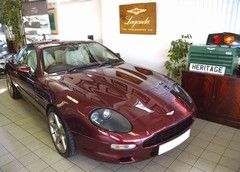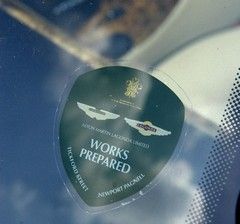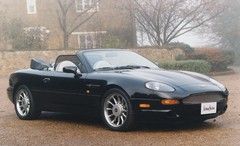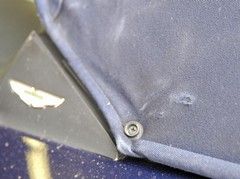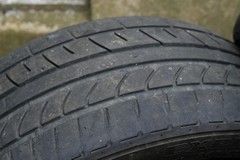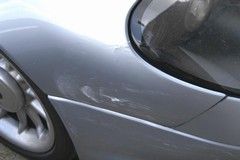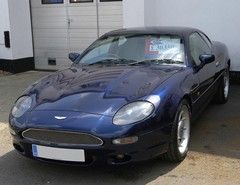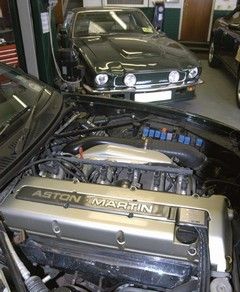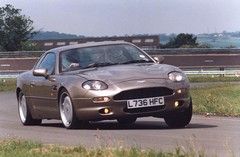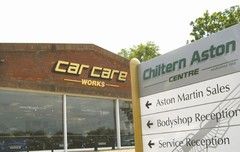Buying a DB7
The DB7 is the most successful Aston of all, but does it make a good used buy? Andrew Noakes reports.

Aston Martin DB7 i6
If you can’t justify spending the £106,850 it will cost you for an Aston DB9, or even the £79,995 a new V8 Vantage will set you back, a tidy pre-owned DB7 might seem an attractive idea. But how do you choose between the early six-cylinder models and the later V12s, or between the coupés and the drophead Volantes, autos or manuals – and where are the pitfalls for the unwary?
To find out, we consulted DB7 evangelist Derek Campbell, of Chiltern Aston, located near Hemel Hempstead.
Let’s deal with coupés and Volantes first. Volantes offer fresh air and optimum pose value, but the hood steals rear seat space. But the decision isn’t simply about how much interior space or headroom you want: Volantes are heavier and their bodyshells more flexible, too, so coupés are the driver’s choice.
“The six-cylinder is very strong, very lazy, very much within the capabilities of the chassis,” says Derek. “You can get in a six-cylinder, thrash it within an inch of its life, and still be safe.” The rarer manual gearbox is preferable, partly because it allows you to rely on the mountain of mid-range torque and partly because the six’s auto gearboxes are not particularly impressive.
V12 Vantage
The V12s have a sharper throttle response, and are more about revs and power than high gears and torque. The V12 cars also provide the better soundtrack, and because they are later cars they benefit from several years further development in everything switchgear to body stiffness. But there are drawbacks to the V12.
The V12s’ styling is more aggressive, but arguably less cohesive. The car’s designer – Ian Callum, then working for TWR but now Director of Design at Jaguar – prefers the purity of the earlier model, and Derek Campbell agrees. But that’s purely subjective: a bigger demerit for the V12 is its running costs: fuel consumption is at least a third greater and servicing is more expensive.
As a result, values of V12 are still dropping while six-cylinder cars have now levelled out at £30,000 or so for good early models, up to around £45,000 for the last ones. V12s start around the same level, and head up to £70,000 or more for late cars. The rare Zagato models go for even more, but special edition versions of the standard car are a different story. “They’re a colour scheme and a bit of embossing on the seats,” says Derek. “On the basis that they built so few DB7s anyway, they’re all limited editions.” But Driving Dynamics and GTS kits, which include suspension and brake upgrades, do add to a car’s value, and are worth a premium of about £3,000.
What can go wrong?
Pre-purchase inspection is an essential, says Derek, because a superficially tidy DB7 can hide problems underneath. Jacking points, radius arm mountings and the front bulkhead are the areas where rust will show up first, but major rust troubles are, so far, very rare. Sometimes the front wings will have what look like rust bubbles under the paint – but the wings are composite. The bubbles are caused by poor repair work, and the only lasting cure is to replace the wings.
Front-end impacts tend to deform the chassis rails under the engine or distort the subframe carrying the engine and suspension mountings, leading to poor handling and uneven tyre wear. On all cars, the wide alloy wheels are strong at the outer rim but less well supported on the inside, and spirited driving over speed bumps can distort the inner rim causing vibrations which can be felt through the steering. Brake discs can also distort, reducing brake efficiency and causing vibrations through the pedal.
Weeping air conditioning gaskets and seals are common, a combination of old technology equipment and the irregular use that is common with DB7s. The worst news is failure of the evaporator unit, which takes two days to replace because most of the interior has to come out.
On Volantes, the hoods are generally well made and reliable, but it’s worth checking the rear quarters of the hood for wear. The hood irons are provided with rubber covers which sometimes go missing, leaving sharp edges which can rub holes in the hood cover. The only possible repair is to cut out the affected area and let in new material, a specialist job. It’s also important to check that the hood cover, which helps keep the headlining clean when the hood is folded, is present and that all the catches work.
The plastic catches which allow the seat backs to tip forward often break, and if they are broken it tells you something important about the owner. If that owner has been careless enough to break the catches, and then lazy enough to leave them like that, where else has maintenance and repair been skimped or missed entirely?
Service history
A full service history is absolutely essential, and it’s equally important that the car has been looked after by a qualified specialist. Stamps in the book from Aston Martin Works Service at Newport Pagnell are about as good as it gets, but equally effective care will be provided by an approved Aston specialist like Chiltern Aston Centre. Gaps in the history should sound warning bells, particularly if they occur at the same time as a change in ownership, and make sure bills for parts match the recommended schedule – it’s easy to fill the service book with oil changes but never do the more expensive maintenance jobs. The factory recommends that all DB7s are serviced every 7500 miles or six months, though an annual service is probably reasonable for cars which cover only low mileages. The biggest service bills come at 30,000 miles for six-cylinder cars and 45,000 miles for the V12s.
Why buy one?
So, does a pre-owned DB7 make sense? Well, no, not really. “It’s not the most efficient car in the world, it’s not the quickest car in the world, it’s not the best built car in the world,” says Campbell. But that’s not the point. If a DB7 is what you’ve set your heart on, little else will do. “It’s passion, desire, aspiration. You’re buying it because you want it.” And, Campbell adds, “it’s the prettiest car that was ever designed…”
Links
Copyright © Andrew Noakes 2005
Gassing Station | Aston Martin | Top of Page | What's New | My Stuff

